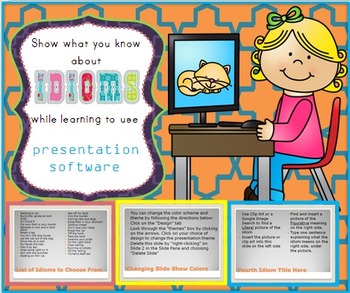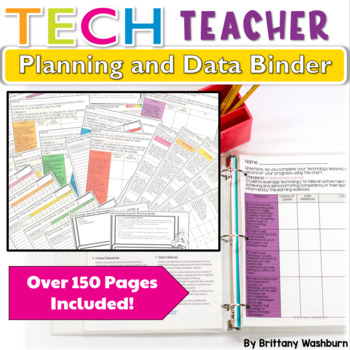Teaching Vocabulary and Technology Skills
Do you have a word wall in your technology classroom? My first year teaching I didn't, and every time I asked my students to write about what they were learning I had to spell EVERYTHING for them. Obnoxious, right? We want our students to use the vocabulary words we are teaching them, so why not put them all up on the walls to help our students see the word and make a connection to the spelling? That is exactly what I've done from my second year and on.
Let's face it, when you're the only one at your school teaching technology you can feel totally alone in planning and curriculum development. Even if you meet with a professional learning team, you're not at the same school working with the same students. You're on your own. This may seem like a big obstacle, but it actually has an upside - no one can tell you how to pace your lessons!
If you're like me, you NEED a few weeks to establish procedures and expectations. I would hate to feel rushed, like most classroom teachers do, to start teaching content within days of beginning school. After I have shown my students how to enter the classroom, how to begin working, where the supplies are, how they may use the supplies, how to log off, and how to line up, then I'm ready to start teaching vocabulary and skills.
I have this winning combination I use for teaching every technology lesson. I start with an essential question, then I talk about the I Can statement and vocabulary for the lesson, then I dive into the directions all without actually teaching them anything yet. When my students log into their computers and access the lesson page on my class website, that is when instruction and independent practice finally takes place. You see, I have a semi-flipped classroom. I LOVE to use screencasts to give the actual instruction for a lesson. I will detail the steps required and give them directions for how to complete the independent practice part. For an example screencast showing students how to insert, move, and resize photos, check this out:
My students learn the answers to essential questions, vocabulary, and a declaration for the I Can Statement from hands on practice.
Let's face it, when you're the only one at your school teaching technology you can feel totally alone in planning and curriculum development. Even if you meet with a professional learning team, you're not at the same school working with the same students. You're on your own. This may seem like a big obstacle, but it actually has an upside - no one can tell you how to pace your lessons!
If you're like me, you NEED a few weeks to establish procedures and expectations. I would hate to feel rushed, like most classroom teachers do, to start teaching content within days of beginning school. After I have shown my students how to enter the classroom, how to begin working, where the supplies are, how they may use the supplies, how to log off, and how to line up, then I'm ready to start teaching vocabulary and skills.
I have this winning combination I use for teaching every technology lesson. I start with an essential question, then I talk about the I Can statement and vocabulary for the lesson, then I dive into the directions all without actually teaching them anything yet. When my students log into their computers and access the lesson page on my class website, that is when instruction and independent practice finally takes place. You see, I have a semi-flipped classroom. I LOVE to use screencasts to give the actual instruction for a lesson. I will detail the steps required and give them directions for how to complete the independent practice part. For an example screencast showing students how to insert, move, and resize photos, check this out:
My students learn the answers to essential questions, vocabulary, and a declaration for the I Can Statement from hands on practice.
These posters are what I have on my whiteboard. I change them out for each class if each class is learning something different that day (but sometimes I like to teach in units and these posters can apply to several classes, the content for the lesson is just a bit different). After we have learned a vocabulary word, I put the word wall version up in the classroom.
Prior to the start of school I printed, cut, and laminated all of the word wall cards and I keep them in a binder until I'm ready to use them.
Now, my students do not simple complete a set of practice questions on the computer and call it a day, we have interactive notebooks for our lessons. I use interactive notebooks for everything, from digital citizenship, (check out this blog post to learn about it) to how to do specific skills in PowerPoint.
Using an interactive notebook means my students are held responsible for the content. Any time they ask me how to do something we've already learned, I direct them back to the correct page in their notebook and they look up the details themselves. In my technology classroom I introduce PPT as early as second grade, but each year I find that I have to re-teach skills like how to change the font and how to insert and resize a picture. This was frustrating to both the students and to me. That's why I decided to create an interactive notebook for these skills, so that students can look back and see the details for how to complete each skill and why we need that skill (all included in the guided notes and activities of my PPT Skills Complete Unit). If you teach multiple grade levels like I do, you may choose to split the instruction of these 14 lessons between 3 years (start in 3rdgrade with the basics, do a few more lessons in 4th grade and finish with the trickiest skills in 5th grade) or something similar.
I’ve had the most success teaching this complete unit in 4thgrade along with a research project. I worked with the teachers and chose to research Idioms (you can find the guided research project hereif you’re interested). We spent weeks learning the PPT skills and then implemented them into a cohesive, and amazing, presentation for each student. Their work was middle school quality after learning all of these skills.
One thing I've noticed since implementing interactive notebooks is that the vocabulary comprehension has increased significantly. Students love to learn with their hands, and having them cut, color, write, and think about the topic in a creative way, means they are engaged in the learning process.
By the way, I plan all of this using a combination of the ISTE NETS-S and the I Can Statements I've created. I have them all compiled into a Technology Teacher Binder that I use to plan and track data for my students, though my 3rd-5th grade students track their own data in a packet that you can find in that binder. This was developed after spending 2 school years frustrated at the lack of resources provided for technology teachers, and it has been the perfect solution.
I hope that reading through this post has given you some ideas for how to meet the technology standards for all of your students. With a little planning and preparation, you can have a smooth-running classroom and your students will barely need you! What other components of a technology classroom would you like to learn about? Let me know in the comments and I will write a post about it.
















Post a Comment